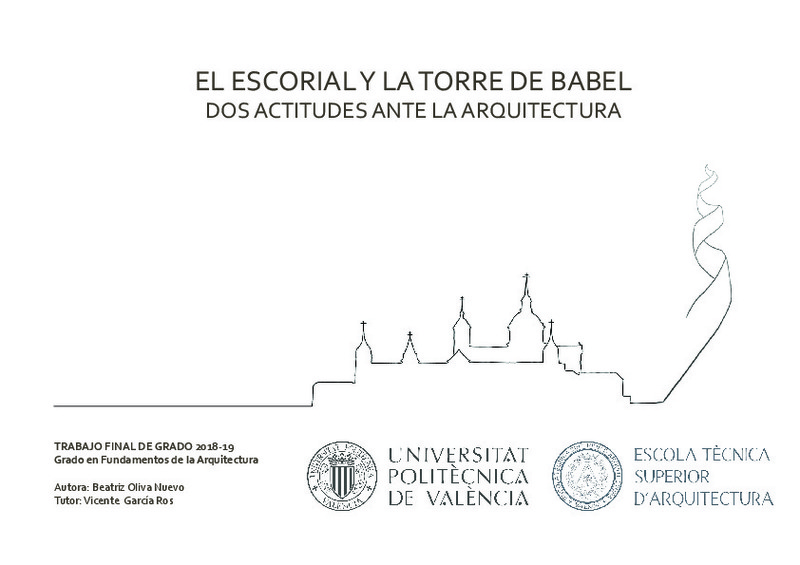JavaScript is disabled for your browser. Some features of this site may not work without it.
Buscar en RiuNet
Listar
Mi cuenta
Estadísticas
Ayuda RiuNet
Admin. UPV
El Escorial y la Torre de Babel. dos actitudes ante la arquitectura
Mostrar el registro sencillo del ítem
Ficheros en el ítem
| dc.contributor.advisor | García Ros, Vicente
|
es_ES |
| dc.contributor.author | Oliva Nuevo, Beatriz
|
es_ES |
| dc.coverage.spatial | east=-4.147735834121704; north=40.58904223384662; name=San Lorenzo Escorial-Battenbrg, 28200 San Lorenzo de El Escorial, Madrid, Espanya | es_ES |
| dc.date.accessioned | 2020-01-20T10:17:46Z | |
| dc.date.available | 2020-01-20T10:17:46Z | |
| dc.date.created | 2019-09-19 | |
| dc.date.issued | 2020-01-20 | es_ES |
| dc.identifier.uri | http://hdl.handle.net/10251/135086 | |
| dc.description.abstract | [ES] Se puede decir que la arquitectura es, entre otras cosas, un reflejo de aquel que lo proyecta, interviniendo factores como la época, clase social, región o cultura. Ante esto, la Torre de Babel y el Monasterio del Escorial manifiestan una clara diferencia de intenciones entre Nimrod y Juan de Herrera. La soberbia de la Torre de Babel sirve como referente a evitar para la construcción del Monasterio del Escorial, buscando así el rey Felipe II la aprobación divina mediante la austeridad. Este trabajo pretende abordar las diferencias, y también las semejanzas, entre una arquitectura real y otra legendaria. | es_ES |
| dc.description.abstract | [EN] It can be said that architecture is, among other things, a reflection of the one who designs it, also intervening factors such as the epoch, social class, region or culture. Given this, the Tower of Babel and the Monastery of El Escorial manifest a clear difference of intentions between Nimrod and Juan de Herrera. The pride of the Tower of Babel serves as a reference to avoid for the construction of the Monastery of the Escorial, seeking thus the king Felipe II the divine approval by means of the austerity. This work aims to discuss the differences, and also the similarities, between a real architecture and a legendary one. | es_ES |
| dc.language | Español | es_ES |
| dc.publisher | Universitat Politècnica de València | es_ES |
| dc.rights | Reconocimiento (by) | es_ES |
| dc.subject | Monasterio de El Escorial | es_ES |
| dc.subject | El Escorial | es_ES |
| dc.subject | Torre de Babel | es_ES |
| dc.subject | Felipe II | es_ES |
| dc.subject | Juan de Herrera | es_ES |
| dc.subject | Nimrod | es_ES |
| dc.subject | Zigurat. | es_ES |
| dc.subject | The Escorial | es_ES |
| dc.subject | Tower of Babel | es_ES |
| dc.subject.classification | COMPOSICION ARQUITECTONICA | es_ES |
| dc.subject.other | Grado en Fundamentos de la Arquitectura-Grau en Fonaments de l'Arquitectura | es_ES |
| dc.title | El Escorial y la Torre de Babel. dos actitudes ante la arquitectura | es_ES |
| dc.type | Proyecto/Trabajo fin de carrera/grado | es_ES |
| dc.rights.accessRights | Abierto | es_ES |
| dc.description.bibliographicCitation | Oliva Nuevo, B. (2019). El Escorial y la Torre de Babel. dos actitudes ante la arquitectura. http://hdl.handle.net/10251/135086 | es_ES |
| dc.description.accrualMethod | TFGM | es_ES |
| dc.relation.pasarela | TFGM\110822 | es_ES |
Este ítem aparece en la(s) siguiente(s) colección(ones)
-
ETSA - Trabajos académicos [4687]
Escuela Técnica Superior de Arquitectura






